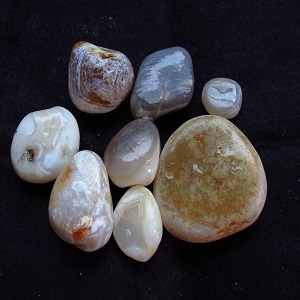?What is a pearl
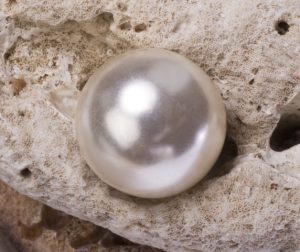
A pearl is a bright and hard gem that is found in the body of a type of bivalve mollusk called a pearl oyster and is rarely produced by a snail. It is thought that its name has a Latin origin and is derived from the word Perna, a kind of oyster, or Sphaerula, which means spherical. The coarse type of this gem is also called “Dor” and Dordane means pearl seed. “Dor Yatim” is said in a way to be alone in the shell
Pearl stone has a hardness of 3 to 4 on the Mouss scale, and the fracture form is shell-like or scaly and basically without cleavage. The shape of this gem is often close to a sphere, but it can also be seen in pear, button and irregular shapes
?How do pearls form inside oysters
The ancients thought that the creation of a stone cutter was from rain
Sometimes it rains in May, in the coolness of the dawn, the oyster floating on the water opens its hard mouth to create a white and rolling shell and places the raindrop in its soft heart. Doing this story after ten years will be a white and bright vision
ancient Iranian
The truth is that when a foreign object is placed between the body and the shell of a bivalve shell of salt water (Mollusco) or fresh water (Mussels), the animal gradually becomes a calcareous substance called “Mother of Pearl” (Mother of Pearl), which is a type of calcium carbonate. Around that particle is secreted and crystallized in the form of layers of aragonite, and over time, the seed of this gem appears
The secreted substance is called “nacre”. The layers of nacre that surround the foreign object gradually increase in volume over time. The chemical composition of nacre is calcium carbonate and an organic substance called conchiolin
?What is a foreign body in a pearl oyster
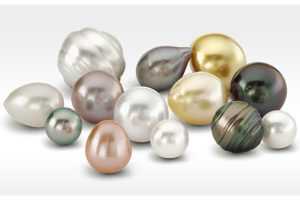
The appearance of this gem in the body of the oyster is natural and completely random, and a foreign body must enter the body of the animal so that it secretes the nacre substance around this body in order to defend itself. The foreign object can be a particle of sand or the baby of some worms or another foreign substance that disturbs the animal’s body. If they break a seed, a foreign body can be seen in the middle of it
Pearl colors
Pearls can be seen in pink, silver, brown or cream and milky, golden, green, blue and black colors. Due to the organic nature of conchiulin, its color can change easily, especially when the water in the crystal loses its color. This phenomenon reduces its durability, in which case our gem first becomes unpolished and dull, then cracked and finally flaky
?What is the reason for pearl shine
The mother-of-pearl luster is produced by the thin sheets of aragonite and shells of conchiuline placed near its outer surface. This phenomenon is called Orient. In this structure, the breaking of light rays and their interference with each other causes the production of rainbow colors on the surface, which is called iridescence phenomenon
Depending on the type of conchiulin substance spread on them, the type of mollusk animal and the water in the sea, they can be seen as spots or regular spots. Some snails, especially Strombus gigas, can produce a shell that has a silky sheen and is of no commercial value
?How deep are pearl oysters
Oysters that produce pearls often live at a depth of 15 meters along the sea coast. Out of every 30 to 40 oysters caught by fishermen, only one oyster contains a stinger. In 1958 in Sri Lanka, large nets were used to collect oysters from the bottom of the sea, which did not produce the desired result and caused the destruction of the rest of the oysters and the fishing of this gem remained a racket in the following years
?How long does a pearl live
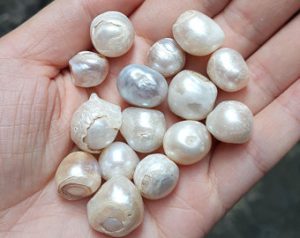
Not much detailed information has been published about this, but probably the pearl seed can live for about 100 to 150 years. Today, there are even types that have lived for several centuries, but they look healthy. The mollusk animal inside the oyster is about eight centimeters long and has an average lifespan of 13 years.
Of course, the correct way to take care of them is also important. If you put it in contact with dry and wet areas, acids, cosmetics, sprays and body sweat, it will damage its durability and polish. it is interesting to know
Sources of pearls in the world
White pearls are obtained from the Persian Gulf and Ceylon (formerly Serandib and today Sri Lanka). Black pearls are mostly obtained from the Gulf of Mexico and the yellow type is obtained from the coast of Australia. The best types in the world are pink and milky white, which are found in the Persian Gulf
Most of the tiny seeds called Seed Pearls are pink and pale yellow in color and come from the Gulf of Mannar, between India and Sri Lanka. The Philippines, Central America, the coast of Tahiti and the South Seas have harvestable fish
The largest pearl in the world
The size of the grain of this gem can be the size of a needle head, a poppy seed, a hazelnut or even a pigeon egg. The largest discovered type of this gem was found in the Philippines by a fisherman. The weight of this quality and pure gem is 34 kg
Biggest Pearl In The World
This fisherman has kept it under his bed for about ten years for luck and finally handed it over to the local authorities. It is interesting to know that this pearl is worth more than one hundred million dollars
Before its discovery a few years ago, the largest type of this gem in the world was called Lao Tzu. The weight of this gem is 6.4 kg and it was extracted from a huge oyster in 1934. The body of the Filipino Muslim diver was found a few days later along with the oyster. In fact, its shape and historical story make it very special
Lao Tzu Pearl
It has been said that the said diver is between the two palms of my power
The oyster was caught and because its shape resembled a human head with a turban, the fishermen called it “Pearl of Allah”. Biologists consider it a pearl, while gemologists consider it a “non-nacre” pearl due to the absence of the iridescence characteristic that is characteristic of the painful types that grow inside molluscs. This gem was valued at 61 million dollars in 2007.
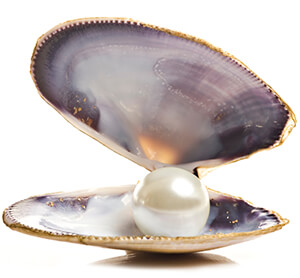
?What is a cultured pearl
In order to get more pearls, fishermen catch the oyster from the sea, and put a foreign particle, which is usually sand, between the shell and the body, after a while it becomes a seed. Then they take the oyster and remove the stinger from its body. This type of pearl is called cultured or artificial
In order to speed up the production process, the beads are considered spherical. Normally, the diameter of 6 to 7 mm is suitable for three-year-old molluscs in terms of volume. Smaller beads are used for younger oysters
Inserting the spherical beads into the mollusk requires high skill, which is mostly done by women. Normally, each person produces 300 to 1000 oysters daily. Today, 90% of the business related to production is breeding
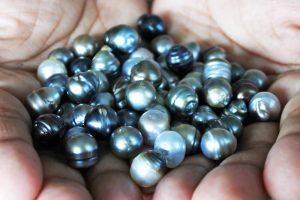
:History of pearl farming in Iran
The results of archeological excavations show that in the centuries before Christ, the inhabitants of the shores of the Persian Sea used the deep-sea fan to obtain pearls. Dr. “Takra Bawat” in his book “The Rulers of Oysters” has considered Iranians as the pioneers of establishing the fishing and cultivation of this gem
The most important document left about the cultivation of this gem in ancient Iran is the report of Apollonius, a Greek mathematician from the island of Rhodes, who lived in the second century BC (262 to 190 BC) at the same time as the Parthian era. In his writing, he clearly mentioned the cultivation of pearls in the Persian Sea and considers it an initiative of Iranians
The divers of the Persian sea went to the oyster while holding a small container containing a fragrant and stimulating plant and caused the oyster to open its mouth
Then they would insert a hollow branch into it and pull out the liquid, bring it to the surface of the water and put it in iron cups filled with sea water, then put a very small pearl in it and wait until make it big
Historical history of pearl fishing in Iran

Since ancient times, the Persian Gulf and the Oman Sea, which the ancients called the Persian Sea, especially the shores of Mish Mahig Island and its beautiful shore (Bahrain (Bahran)) have been considered the birthplace and origin of pearls. The inhabitants of the shores of the Persian Sea have had a long-standing relationship with this gem
In the past, pearls played the current role of oil in the Persian Gulf. According to historical writings, this gem has been hunted since the Achaemenid period, but without a doubt, its familiarity goes back to the distant times in the depths of history. In the writings and Iranian literature of a thousand years of Iranian poets and writers, its fishing is mentioned
The history of deep diving and diving in the south of Iran dates back to centuries BC. During the Median period, Iranians used divers to extract gold and jewel boxes from sunken ships from the sea. The powerful Iranian navy was equipped with a diving group during the Achaemenid, Parthian and Sasanian eras. They have had many skills to penetrate into fortresses through ditches full of water and waterways of cities
In the 4th century of the Hijri, in the book Masalak al-Mamalek, the Iranian geographer Astakhri wrote that pearls were taken from the shores of the Persian Gulf into the country and the pearls of the Persian Gulf were unparalleled. Abu Abdullah Idrisi describes the method of fishing for this gem in the Persian Gulf in Nozha Al-Mushtaq, which was written in the 6th century of Hijri
?What is artificial pearl
Today, there are many artificial pearls in the market, one of them is the Australian “blister cheek” type, which has a thin layer of secreted aragonite or “mother of pearl” material, but it is not considered pearly. Another type is called fake fish scales, which is made of glass coated with scales (which are obtained from various types of fish)
Others use parts of sea snails, freshwater pearl oysters, and teeth of warm-blooded marine animals such as manatees. Also known as Operculum or “Chinese cat’s eye”, this pearl is actually a convex shell of a type of snail that is found around the Australian islands.
The method of distinguishing natural pearls from artificial ones
Natural types have a layered and concentric structure, while the internal structure of cultured types is variable and depends on the type of spherical nut that is placed inside the shell as the primary nucleus.
If you scratch the surface of the original pearl with your fingernail, its powder will be produced. If this is not the case in the replacement type. It is interesting to know that due to its semi-spherical shape, sometimes the cut parts are repaired with aragonite (the same naturally secreted substance of molluscs).
The difference between the natural type and the cultured type can be in their weight. That is, natural pearls are heavier than waxy artificial pearls by more than 50%. Of course, the synthetic type of glass is heavier than its natural type.
The specific weight of natural types is usually less than 2.73, while in cultivated type it is more than the number mentioned.
It is highly unlikely that natural pearls will be perfect and round, smooth and symmetrical like their counterparts. So try to look for details on its surface. Artificial species reflect the same light due to being round and smooth, while in medical

